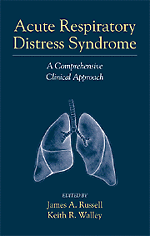Book contents
- Frontmatter
- Contributors
- Contents
- Preface
- Introduction
- 1 Overview, Clinical Evaluation, and Chest Radiology of ARDS
- 2 The Epidemiology of ARDS
- 3 The Pathology of ARDS
- 4 Cytokine -Induced Mechanisms of Acute Lung Injury Leading to ARDS
- 5 Pulmonary Pathophysiohgy in ARDS
- 6 Cardiovascular Management of ARDS
- 7 Mechanical Ventilation
- 8 Respiratory Muscles and Liberation from Mechanical Ventilation
- 9 Clinical Assessment and Total Patient Care
- 10 ARDS: Innovative Therapy
- 11 Nosocomial Pneumonia in ARDS
- 12 Resolution and Repair of Acute Lung Injury
- 13 Multiple System Organ Failure
- 14 Outcome and Long-Term Care of ARDS
- Index
Introduction
Published online by Cambridge University Press: 05 October 2010
- Frontmatter
- Contributors
- Contents
- Preface
- Introduction
- 1 Overview, Clinical Evaluation, and Chest Radiology of ARDS
- 2 The Epidemiology of ARDS
- 3 The Pathology of ARDS
- 4 Cytokine -Induced Mechanisms of Acute Lung Injury Leading to ARDS
- 5 Pulmonary Pathophysiohgy in ARDS
- 6 Cardiovascular Management of ARDS
- 7 Mechanical Ventilation
- 8 Respiratory Muscles and Liberation from Mechanical Ventilation
- 9 Clinical Assessment and Total Patient Care
- 10 ARDS: Innovative Therapy
- 11 Nosocomial Pneumonia in ARDS
- 12 Resolution and Repair of Acute Lung Injury
- 13 Multiple System Organ Failure
- 14 Outcome and Long-Term Care of ARDS
- Index
Summary
Acute respiratory distress syndrome (ARDS) is a very important problem in critical care medicine. First, ARDS occurs commonly in young, previously well individuals who have major insults such as multiple trauma, sepsis, and aspiration of gastric contents. Second, the mortality of ARDS remains relatively high at 40% to 60% despite improvements in drug therapy, mechanical ventilation, hemodynamic management, more potent antibiotics, better prevention of complications (e.g., stress ulceration), better supportive care (e.g., nutrition), and more effective methods of weaning from ventilation. Encouragingly, there are some indications that the mortality of ARDS may be decreasing. Third, the health care costs of ARDS are considerable because patients are almost exclusively managed in an expensive ICU setting. There is considerable pressure to contain costs and to improve the cost effectiveness of ARDS. Finally, ARDS is important because the quality of life for survivors of ARDS is good with generally very good to excellent return of pulmonary function, good return to quality of life in many, and even preliminary reports of excellent return of quality of life in most.
ARDS has been defined more precisely by an American-European Consensus Conference. Acute lung injury preceding ARDS is defined by presence of bilateral infiltrates on chest roentgenogram, no evidence of congestive heart failure (or pulmonary artery occlusion pressure less than 19 mmHg if a pulmonary artery catheter is in place), need for mechanical ventilation, and PaO2/FiO2 less than 200. Severe ARDS is similarly defined, except the PaO2/FiO2 ratio must be less than 100.
- Type
- Chapter
- Information
- Acute Respiratory Distress SyndromeA Comprehensive Clinical Approach, pp. 1 - 5Publisher: Cambridge University PressPrint publication year: 1999



